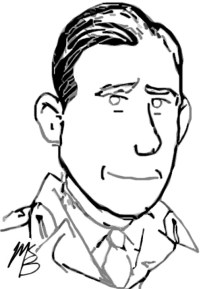Brigadier Ben Cunningham
Queen’s Own Cameron Highlanders
9th Infantry Brigade

I was always damned proud of my men. Never once did I hear of an officer or any man wanting to call it quits.
(Quoted in Kingston Whig-Standard, 6 Jun 1980, 7)
Born on 22 March 1908 in Kingston, Ontario, Douglas Gordon (Ben) Cunningham graduated from RMC in 1929 and studied law at Osgoode Hall. In addition to being lawyer and city alderman in Kingston, he was adjutant with the Princess of Wales’ Own Regiment, but he vacated all these roles to go overseas in 1940. He was appointed aide-de-camp to Major General Victor Odlum of the 2nd Division before serving as brigade major of the 4th Infantry Brigade during the Dieppe Raid of 19 August 1942.
He directed brigade operations from a landing craft, maintaining a crucial link with the force headquarters ship. As his Distinguished Service Order citation described, throughout the battle, Cunningham:
set an outstanding example of devotion to duty and coolness under heavy fire… His calmness and utter disregard for his personal safety were a constant inspiration to his men. Major Cunningham had played an essential part in the preparations for the raid, and this combined with his courage and determination during the actual operation constitutes a very important contribution to its success.
Despite the optimism of the citation, the Dieppe Raid has not been regarded as a success given the virtual decimation of nearly all the battalions involved. The Queen’s Own Cameron Highlanders lost their commanding officer Lieutenant-Colonel A.C. Gostling as soon as he stepped on ashore, and the regiment returned with half of its strength. In late August 1942, Cunningham was appointed to command the depleted Camerons.
After a five-month tenure in command, in January 1943, he was succeeded by Major A.T. Law who had performed heroically at Dieppe after the death of Gostling. Cunningham went on to be general staff officer with Canadian Headquarters, serving for a time in Sicily. By the end of the year, he had returned to England with a promotion to brigadier in charge of the 9th Infantry (Highland) Brigade.
As part of the 3rd Canadian Division, the 9th Brigade made the landing at June Beach on 6 June 1944. “It was very different from the Dieppe landing. Here we had a feeling of great confidence in the planning and in our ability to execute it,” Cunningham recollected in later years. “We were not fired upon during the actual landing and there was little enemy aircraft activity.”
As the heavy fighting got underway, he clashed with Major-General Rod Keller of the 3rd Division, who filed an adverse report on his brigadier. Cunningham raised his concerns about Keller’s competence with II Canadian Corps commander Guy Simmonds, who delayed making a decision on removing a senior general early in the campaign.
Following heavy losses in Operation Spring in late July 1944, Lieutenant-Colonel Charles Petch of the North Nova Scotia Highlanders convinced Cunningham that a further assault would be futile for his depleted battalion. Although Cunningham agreed, Keller, who had directed the attack, and Simonds determined to remove both subordinates. In early August, Simonds sacked Cunningham, Petch, and Lieutenant-Colonel G.H. Christiansen of the Stormont, Dundas and Glengarry Highlanders, another battalion commander who refused the attack order.
Simonds finally resolved to remove Keller who was then wounded in the friendly fire bombing incident on 18 August. In later years, Simonds began to second guess his hasty removal of some subordinate commanders. According to Simonds’s biographer, “Recollections of Normandy started Guy talking … He still worried whether he ought to have sacked Keller and saved Cunningham. He was concerned that he had prosecuted the war with his whole soul and personality and without regard for persons. Anything that did not fit into his scheme of things he had taken as a personal challenge. But beneath the confident exterior Guy was ever a worrier.”
Now removed from the battlefield, Cunningham received a consolation post as RMC commandant, returning to his old school in September 1944. He stepped down at the end of the war and retired from the army. He resumed his law practice in Kingston and was made King’s Counsel in 1946.
The last surviving Canadian general to land on D-Day, Cunningham died in Kingston on 18 July 1992.